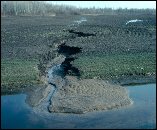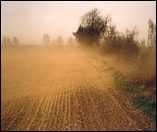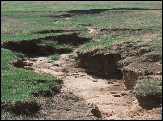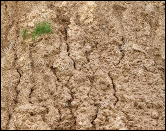Unit – 3
NATURAL RESOURCES
Any material which is part of earth and satisfy human need and add value is called as resource. Types Of Resources -
- Natural Resources
- Human Resources
- Man-made Resources
Natural Resources includes air, water, forests, animals, fishes, marine life, biomass, fossile fuels, like coal, petroleum and natural gases, wild life, renewable energy sources like solar energy, wind energy, biomass energy, geothermal energy etc. Prosperity of a nation is dependent on the natural resources available in the nation.
Resources which are available on land are called land resources. Land is the most important valuable resource for mankind. Land resources includes natural vegetation, wild life, human life, economic activities, transport and communication. Moreover, most of our basic needs like food clothing and shelter comes from land. Therefore, careful use of land is necessary.
Land use change is a process which transforms the natural landscape by direct human-induced land use such as settlements, commercial and economic uses and forestry activities. Land use change simply refers to the conversion of a piece of land's use by humans, from one purpose to another. It impacts the overall environment in terms of greenhouse gas emission, land degradation and climate change.
Direct land use change As with direct land use, direct land use change refers to a specific piece of land, whose use has been converted by humans from one purpose to another. For example, a piece of land used for forestry might be deforested and then replaced by new cropland.
Indirect land use change Indirect land use change takes place when a direct change in land use in one location, is causally connected to a corresponding change in land use in another location. The causal mechanism behind this shift in land use from one location to another is the influence of agricultural markets on regional or global land use.
Land degradation is a process of deterioration of soil or loss of fertility.
Effects of land degradation:
- Soil texture and soil structure are destructed.
- Loss of soil fertility.
- Loss of valuable nutrients.
- Increase in water logging, salinity, alkalinity and acidity problem.
- Loss of economic social and biodiversity.
Causes of Land Degradation:
- Population: More land is needed for producing food, fibre and fuel wood. So land is degraded due to over exploitation.
- Urbanisation: Urbanisation reduces the agricultural land. Urbanisation leads to deforestation, which in turn affects millions of plants and animals.
- Fertilizers and pesticides: It affects fertility of the soil and causes land pollution.
- Damage of top soil: Increase in food production generally leads to damage of top soil through nutrient depletion.
Soil is the loose material lying on the surface of the earth. Soil is formed by the disintegration and decaying of rocks by the weathering process. It refers to loss of the top fertile layer or part of the soil by natural agencies like running water, ward and sea waves. Different types of Erosions are :
 Sheet erosion : Sheet erosion is refers to uniform Removal of soil Over a large area from the surface of Sloping lands by Rain water.
Sheet erosion : Sheet erosion is refers to uniform Removal of soil Over a large area from the surface of Sloping lands by Rain water.
 Wind soil Erosion: Which is caused by wind, more effective in arid and semi arid regions.
Wind soil Erosion: Which is caused by wind, more effective in arid and semi arid regions.
- Gully Erosion: Refers to the eroding of soil in its course by rain water running along the slopes in the Form of rills or valleys .

 Rill Erosion: Refers to eroding of the soil in core use by rain water running along the slopes in the form of channel.
Rill Erosion: Refers to eroding of the soil in core use by rain water running along the slopes in the form of channel.
Causes of Soil Erosion
- Floods
- Careless and excessive irrigation
- Improper methods of cultivation
- Strong winds
- Heavy rainfall
- Over Grazing
- Deforestation
Harmful effects of soil erosion
1. Soil fertility decreases due to the loss of top soil layer.
2. Loss of it’s ability to hold water and sediments.
3. Sediments run off can pollute water and kill aquatic life.
Desertification
It is a process which involves loss of regenerative capacity of soil due to depletion or absence of plant supporting factors .
Causes for desertification
- Deforestation
- Over exploitation of soil cover
- Over grazing.
- Improper agricultural practices
- Strong winds
- Control measure
- Regulation of cutting trees
- Control of over grazing
- Growing of ecologically suitable plants in affected areas
- Public awareness
- Proper farming practices
- Proper use of available ground water
Deforestation means reckless or large-scale felling or cutting of trees by man for commercial and other purposes. Deforestation refers to the decrease in forest areas across the world that are lost for other uses such as agricultural croplands, urbanization, or mining activities.
Mining is one of the main causes of deforestation. The environmental impact of mining includes soil erosion, formation of sinkholes, loss of biodiversity, and contamination of soil, groundwater and surface water by chemicals from mining processes. Mining occurs so as to extract precious metals and gemstones such as Manganese, tantalum, cassiterite, copper, tin, nickel, bauxite (aluminum ore), iron ore, gold, silver, and diamonds which are found in many tropical rainforests. These metal such as gold is then used to make jewellery. Mining is a destructive activity that damages the rainforest ecosystem and causes problems for people living nearby and downstream.
Mining has a huge impact on those who are exposed to the toxic waste from the tailings. People living there may start to develop skin rashes, headaches, vomiting, diarrhea and other medical conditions. Many people who cannot afford to go to a doctor or live in a village where medication is not accessible, are often not treated for their illnesses and resulting in their death. Forests are cleared to establish the mines and construct roads to transport the materials. While deforestation and chemical pollution from mining can impact the rainforest environment, it can affect aquatic habitats even more. Reduced water flows caused by deforestation can seriously affect local fish populations.
- Water Supply - Dams gather drinking water for people.
- Irrigation – Dams helps farmers bring water to their farms
- Hydroelectrical - Dams help create power and electricity from water.
- Flood control – Dam keep areas from flooding.
- Recreation – Dams create lakes for people for their needs
A forest is a community of trees, shrubs, herbs, and associated plants and organisms that cover a considerable area that use oxygen, water and soil nutrients as the community attains maturity and reproduces itself.
Types of forests
There are different types of forests which can be seen in different parts of the world
- Deciduous forests
- Rainforests
- Tropical rain forests
- Temperate rain forests
- Coastal forests
- Coniferous forests
- Broad leaves forests
- Thorn forests
Biodiversity : Bio = Diversity = Variety
The term Bio-Diversity was first coined by Walter G. Rosen in 1986. Biodiversity, refers to the variety of life on Earth. It includes diversity of ecosystems, species and genes, and the ecological processes that support them. Everything that lives in an ecosystem is part of the web of life, including humans. Each species of vegetation and each creature has a place on the earth and plays a vital role in the circle of life. Plant, animal, and insect species interact and depend upon one another for what each offers, such as food, shelter, oxygen, and soil enrichment. Maintaining a wide diversity of species in each ecosystem is necessary to preserve the web of life that sustains all living things.
There are three levels of Diversity
- Species diversity
- Genetic diversity
- Ecosystem or Habitat diversity
Species diversity: The species diversity peaks in the tropical forest and coral reefs. India has around 2,00,000 species of the total species described.It is defines as variety of different species of living forms in a given area.
Genetic diversity: These variations help the individuals to have a variant that help it to be suite for the new environment. The more genetic diversity in a population, the more chances in variations.
Ecosystem or Habitat diversity: Ecosystem is the structural and functional unit of the biosphere. Ecosystem diversity is defined as „the aggregation of various habitats, community types and abiotic environment in a given area‟. India has one of the richest ecosystem diversity, ranging from deserts, plains, hills, mangroves, rainforests to cold Himalayas. Out of the 18 hot spots of biodiversity recognized in the world, India has two of them, Eastern Himalaya and The Western Ghats. Eastern Himalayas is recognized as the “Cradle of Speciation” due to rich diversity of primitive flowering plants.
Threats to Biodiversity Natural causes:
- Domino effect
- Agriculture
- Global warming and climate change
- Hunting
- Pollution
- Innovation by exotic species.
- Overexploitation of selected species
- Habitat modification
- Low breeding rate
- Low population
- Narrow geographical area
Water resources are sources of water that are useful or potentially useful. • Uses of water include agricultural, industrial, household, recreational and environmental activities. • Virtually all of these human uses require fresh water
Water Resources-Use and Overutilization :
- The water Cycle through evaporation and precipitation, maintains hydrological systems .
- All aquatic ecosystems are used by a large number for their daily needs such as washing irrigation, cooking etc.
- One of the greatest challenges today is the management of these water resources.
- Due to increasing population there is an enormous supply for the available freshwater resources. India is likely to face water crisis by 2025.
- With growth of human population larger amounts of water will be required to fulfill basic needs Today in many areas this need cannot be met.
- Overutilization of water occurs at various levels:
- Most people use more water than required to carry out basic activities such as brushing, bathing, washing and cleaning etc.
- Farmers also sometimes use double the water required for irrigation.
- There are many ways in which the farmer can increase the yield by using less water for irrigation.
- With the growth of human population there is an increasing need for larger amounts of water to fulfil a variety of basic needs. Today in many areas this requirement cannot be met.
- Overutilization of water occurs at various levels. Most people use more water than really needed. Most of us waste water during a bath by using shower or during washing of clothes. Many agriculturists use more water than necessary to grow crops. There are many ways in which farmers can use less water without reducing the yields such as the use of drip irrigation systems.
- Agriculture also pollutes surface water and underground water stores by the excessive use of chemical fertilizers and pesticides. Methods such as the use of biomass as fertilizers and non toxic pesticides such as neem products reduces the agricultural pollution of surface and ground water.
Industry tends to maximise short-term economic gains by not bothering about its liquid waste and releasing it into the streams, rivers, sea.
Floods : Floods have been a serious environmental hazards from centuries. Deforestation causes flood that kills people, damage crops and destroys homes. • Rivers changes its course during floods and tons of valuable soil is lost to the sea. As the forest are degraded, rain water no longer percolates slowly into the the sub-soil but runs off down the mountainside bearing large amount of top soil.
Droughts : In most arid regions of the world the rains are unpredictable. This leads to a periods when there is a serious scarcity of water to drink, use in farm, or provide for urban or industrial use. One of the factor that worsens the effect of droughts is deforestation. Drought is one of the major problem in our country, due to unpredictable climatic condition or due to the failure of one and more monsoon.
Conflict Over Water
- Conflicts through use -Unequal distribution of water has often led to inter state or international disputes
- Constructions of dams -Hydroelectric power generation, dams are built across the rivers, which initiates conflict between the states.
Renewable Resource is energy which is generated from natural sources i.e. sun, wind, rain, tides and can be generated again and again as and when required. They are available in plenty and by far most the cleanest sources of energy available on this planet. Solar Energy, Wind Energy, Geothermal Energy, Biomass Energy from Plants, Tidal Energy are the examples of Renewable resources.
Non Renewable Resource is a natural resource that cannot be re-made or re- grown at a scale comparable to its consumption. Non-renewable sources are not environmental friendly and can have serious effect on our health. They are called non-renewable because they cannot be re-generated within a short span of time. Non-renewable sources exist in the form of fossil fuels, natural gas, oil and coal
Use of Alternate Energy Sources
Alternative energy is energy that does not come from fossil fuels, and thus produces little to no greenhouse gases like carbon dioxide (CO2). This means that energy produced from alternative sources does not contribute to the greenhouse effect that causes climate change.
These energy sources are referred to as “alternative” because they represent the alternative to coal, oil, and natural gas, which have been the most common sources of energy since the Industrial Revolution. These fossil fuels emit high levels of CO2 when burned to produce energy and electricity. Alternative energy, however, should not be confused with renewable energy, although many renewable energy sources can also be considered alternative. Solar power, for example, is both renewable and alternative because it will always be abundant and it emits no greenhouse gases. Nuclear power, however, is alternative but not renewable, since it uses uranium, a finite resource
- Solar Power. When most people think of alternative energy sources they tend to use solar power as an example.
- Nuclear Power
- Hydroelectric Energy
- Wave Energy
- Biofuels
- Natural Gas
- Geothermal Power
- Wind Energy
Growing Energy Need
The world will need significantly increased energy supply in the future, especially cleanly-generated electricity. Electricity demand is increasing about twice as fast as overall energy use and is likely to rise by more than half to 2040.
Reference Books
- Environmental Engineering by Anil Kumar De et al
- Introduction to Environmental Engineering by Davis et al
- Environmental Engineering-1 by H.S Vishwanath et al